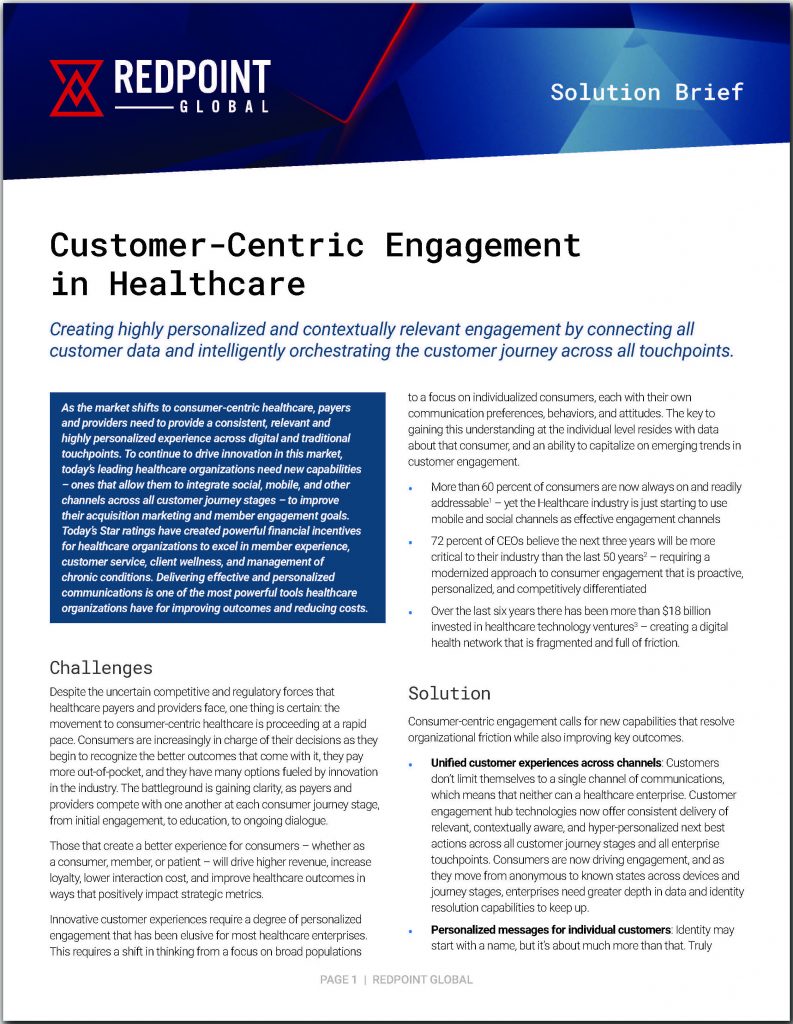 Healthcare organizations – whether payers, providers, retail pharmacies or medical device manufacturers – are increasingly using first-party, second-party, and third-party data to personalize engagement with consumers. Using this data to know all that is knowable about an individual consumer, healthcare enterprises can engage in more targeted marketing to acquire new members and patients and to provide personalized communications as part of the ongoing engagement that improve outcomes.
Healthcare organizations – whether payers, providers, retail pharmacies or medical device manufacturers – are increasingly using first-party, second-party, and third-party data to personalize engagement with consumers. Using this data to know all that is knowable about an individual consumer, healthcare enterprises can engage in more targeted marketing to acquire new members and patients and to provide personalized communications as part of the ongoing engagement that improve outcomes.
Organizations are at varying stages in collecting and using this data to drive improved performance. One example includes using a variety of third-party attributes to better understand lifestyle, behaviors, age, and location to personalize messages when acquiring new consumers. Second-party data is key to value-based care initiatives where providers get claims data from payers, and payers get electronic health record (EHR) data from providers to treat consumers more holistically in driving to improved outcomes. This can be combined with first-party data (data originating from within the enterprise), and with other third-party data such as population health data to then recommend the next best action that may fill a gap in care. This may include outreach to set up an appointment for a baseline body mass index (BMI), a test for diabetes, a mammogram, or another screening. Those recommendations may then be delivered through a digital channel directly to the consumer, or via a primary care physician or other practitioners.
There are emerging uses of first-party and third-party data as social determinants of health, which are a collection of data points that predict the propensity of a person to stay healthy. These can be gathered as first-party data directly from consumers in the form of measured behavior or self-provided information or from third-party data providers.
The Centers for Disease Control lists five social determinants of health: genetics, individual behavior, social environment, physical environment, and access to health care. The Massachusetts Medical Society ranked the impact that each of these determinants have on a person’s overall health. Individual behavior accounts for 40 percent, ahead of genetics (30 percent), social environment (15 percent), healthcare (10 percent), and environment (5 percent).
Because the healthcare a person receives influences only a small percentage of their predisposition to health, healthcare organizations are increasingly using social determinants of health to prescribe treatment and preventive measures, with goals to improve outcomes and reduce cost.
The use of social determinants is a recognition that a consumer’s healthcare experience or journey isn’t isolated to interactions with providers but is instead a continuous path that reflects our always-changing behaviors and environment. It’s our daily diet, exercise patterns, and genetic footprint, yes, but it’s also how much natural light we’re exposed to throughout the day, how close we live to a park or green space, and our level of access to the internet and emerging technologies.
Trailblazers have implemented many innovative programs that produce results. Health Net, a California insurer, used geo-spacing mapping to increase childhood immunization rates by 7 percent. Since 2016, Geisinger Health Systems has provided fresh produce to diabetes patients in counties with high rates of long-term complications. Project leaders of the Fresh Food Farmacy program have reported significant improvements in clinical outcomes for enrollees of the program, which was instituted with the specific intent to address food insecurity, an important social determinant of health.
Many of these types of initiatives are driven by the trend toward value-based care, which measures health outcomes against the cost of the care provided. The idea is that by better understanding an individual’s social determinants, healthcare organizations can promote better outcomes by positively influencing consumers through education and access.
Why Data Matters in Understanding the Healthcare Journey
There are several challenges for healthcare organizations to begin using third-party data such as social determinants of health to evaluate each person holistically. First, they generally do not have access to all the data they need. They may have a person’s medical history, for example, but are unaware of their occupation, where they live, or other baseline information. Without knowing all that is knowable, it is difficult to make sound decisions supported by relevant data.
Data siloes are largely responsible for a pervasive lack of data access, caused by a lack of data sharing across the healthcare spectrum such as between a primary care doctor and a specialist, or between a hospital and an outpatient clinic. Incomplete data input is also a factor; healthcare organizations often do not know all that is knowable because they’re either not asking the right questions, or they cannot integrate the data with a patient’s medical history.
One provider developed innovative social determinants of health screening tool, which is included in an EHR and combined with clinical data to provide caregivers with a more complete patient profile. The data is then queried against a database of local community resources, which returns a list of resources and services that meet a patient’s specific needs.
Second, even with access to the right data, healthcare organizations may not be effectively using it if it has not been integrated into a single view of the customer. Matching records by patient ID within one system is relatively straight forward, but integrating third-party data, device data, mobile, and web behavior data requires advanced matching capabilities. This data also needs to persist as healthcare journeys are long and complex, and the impacts need to be measured over time. Behavior data and third-party data is particularly important as these areas account for over 50 percent of the potential to impact outcomes.
Third, even professionals on the bleeding edge of using first-party, second-party, and third-party data may not have the data in the proper timeframe. Relevance is important, particularly when moving from managing populations to influencing individuals; even with social determinants of health screening tool or a similar innovation, a monthly batch file does little good when conditions change by the minute. Diet and exercise regimens provide a familiar example. Less clear but potentially equally important could be a job loss or promotion, a relocation, or becoming a caregiver to an aging parent.
Real-time data access provides healthcare organizations with the capability to make a next-best action or recommendation for treatment in the right context and cadence of an individual’s healthcare journey. Machine learning algorithms that continuously update a health “score” based on data from any source measure the pulse, if you will, of the healthcare consumer at any moment in time.
Personalizing the Healthcare Experience
One reason for an uptick in treating health and healthcare as a holistic journey is that it aligns with a person’s digital experience as a consumer of most goods and services. The continuously connected consumer interacts with brands across multiple channels and devices, and there is an expectation for a brand to know the consumer as an individual across dynamic journeys.
Healthcare is trending in the same direction, driven largely by the empowered consumer whose healthcare touchpoints are no longer limited to point of care interactions. Connected activity trackers such as Fitbit and Apple Watch provide the consumer with the capability to monitor and measure personal health statistics in real time. We have smartphone apps that monitor our sleep patterns, customize exercise and meal plans, and serve as personal health coaches. These data-driven, digital experiences put the consumer in charge of their own healthcare experience.
An empowered consumer adds a twist to the challenges in leveraging social determinants of health. A healthcare consumer wants more than better outcomes and lower costs, two of the main benefits of using social determinants of health. They also want an overall better experience, of which improved outcomes and lower cost only play a part, however important.
Much like in retail, banking, and other industries, an improved experience means personalization. Yet according to the healthcare consumer, payers, in particular, have a lot of room for improvement. According to the 2018 U.S. Health Insurers Customer Experience index, health insurers ranked 15th out of 19 U.S. industries for providing a positive customer experience.
There are countless ways for healthcare organizations to personalize the healthcare experience, such as a rewards-based initiative for a consumer that meets monthly health goals, triggered through an integration with the consumer’s smart device data. If healthcare organizations are transparent about the use of social determinants of health, consumers could opt-in to innovative programs like the Fresh Food Farmacy where healthcare professionals become their partner in their day-to-day healthcare journey.
For a consumer with a chronic condition, the use of social determinants could inform a more personalized approach to education and treatment beyond the basics such as age-based risk factor. A positive customer experience is also about engaging with the consumer in their preferred channel. Perhaps they want SMS appointment reminders but expect a phone consultation in advance of any first-time preventive screenings.
Treat Me Like a Consumer, Not a Patient
In general, a positive healthcare experience stems from healthcare organizations using data to take friction out of a consumer’s healthcare journey and becoming more proactive in treating the consumer holistically. Knowing all there is to know about the consumer to include full access and use of social determinants of health is a key step in the process, which is bolstered by real-time decisioning to offer a next best recommendation for treatment or engagement.
Healthcare data management extends far beyond maintaining thorough medical records. Today’s knowledgeable and empowered consumer expects the healthcare professionals they interact with to know them as an individual beyond what’s written on a chart. By overcoming data management obstacles such as access, use, and speed and personalizing an end-to-end consumer healthcare journey outside the walls of a doctor’s office, healthcare professionals can provide the consumer what they most value: improved outcomes, personalized experiences, and reduced cost.
RELATED ARTICLES
TRANSCEND19 Shines a Light on the Personalized Customer Experience
The Role of Personalization in Value-Based Care
How Healthcare Payers and Providers Can Harness Big Data for Big Results

